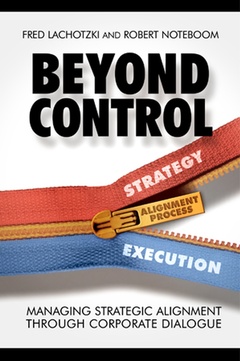Description
Beyond Control
Managing Strategic Alignment through Corporate Dialogue
Authors: Lachotzki Fred, Noteboom Robert
Language: English
Subject for Beyond Control:
Keywords
possible; philosophy; technology; management; new; control; managers; dialogue; welcome; centre; executive; successful; best; large; execution; leadership; organizations; sessions; company; motivational; strategy; amount; travel; decentralize
42.09 €
Subject to availability at the publisher.
Add to cart256 p. · 15.9x23.4 cm · Hardback
Description
/li>Contents
/li>Biography
/li>
Introduction ix
A new approach x
The research base xi
Strategic pull and operational push xii
Strategic alignment and the corporate black box xii
Operating arena xiii
Corporate dialogue xiii
The executive dialogue centre xiv
Moving beyond control xiv
Layout of the book xv
Flowchart xviii
Acknowledgements xix
Part I: Moving Beyond Control: A New Concept 1
1. Strategic Alignment: Is a New System Needed? 3
The profitability equation 3
Moving beyond control 4
How things can go out of control 5
How problems were caused by the operations being ‘black boxed’ 7
Opening up the black box 11
Lessons learned 12
2. The Corporate Black Box: Understanding History 13
Looking back 13
A new approach 33
Lessons learned 35
3. The Operating Arena: Aligning the Space 37
The operating arena explained 37
A dynamic space 39
The theory of strategic alignment 43
Measuring alignment of capabilities 45
The organizational capability scan 46
A management style for strategic alignment 53
Lessons learned 55
4. Leadership Beyond Control: Creating the Push 57
The ideal leadership 57
Aligning strategy and execution 59
Participation: Leading from the middle 61
Combining power and authority:
Creating a culture of respect 63
Managing by strategic pull and operational push 64
Measuring the capacity for alignment 66
Lessons learned 74
Part II: Creating Alignment: The Continuous Dialogue 75
5. The Corporate Dialogue: Activating the Agenda 77
Measuring, matching and managing 77
Measuring 79
Matching: Creating the alignment agenda 83
Managing 86
Lessons learned 91
6. The Executive Dialogue Centre: Installing the Toolbox 93
The executive dialogue centre 93
Ten reasons for establishing an executive dialogue centre 97
The process of managing beyond control 103
Lessons learned 105
7. The Fundamentals: A Mindset for Pull and Push 107
Four pillars 107
Managing complexity is about letting go 108
Individual freedom supports commitment 114
Transparency and accountability are assets 115
Shared uncertainty reduces fear 117
Lessons learned 119
Part III: Managing Alignment: Leading, Rewarding and Reporting 121
8. The Chief Executive Officer: Believer-in-Chief 123
Intent: Being an internal and external role model 124
Objectives: Goals that hit home and please people 133
Resources: Making managers unlock people’s potential 136
Interaction: Taking charge of communication 137
The corporate dialogue process 141
Lessons learned 145
9. The Chief Financial Officer: Guarding the Equation 147
Intent: Creating total clarity 148
Objectives: Linking score with capabilities 152
Resources: Focus on facilitation and reality 155
Interaction: The conscience behind the data 155
Lessons learned 157
10. The Human Resource Director: Aligning Talent 159
Intent: Giving the right people the real story 161
Objectives: Fighting for meritocracy 170
Resources: Being committed to engagement 173
Interaction: Fighting for openness 178
Lessons learned 182
11. The Communications Director: The Coherent, Consistent Storyline 185
Intent: Making sense of strategy through interaction 187
Interaction: Managing the ecosystem of dialogue 192
Objectives: Enabling individual agendas to be aligned with the strategic alignment agenda 196
Resources: Infrastructure as an enabler for consistency 196
Lessons learned 197
Epilogue 199
Appendix I: Gap Analyses 201
Appendix II: Campaign Invitations and Protocols 203
Appendix III: A Case Study on Measuring – ABN AMRO 205
Appendix IV: A Case Study on Matching – Numico 208
Appendix V: A Case Study on Managing – Sara Lee/DE 211
Appendix VI: How Aligned Is Your Company? 215
Notes 217
Index 221
ABOUT THE AUTHORS
FRED LACHOTZKI (RIGHT) has thirty years of experience as manager, president and nonexecutive director in E e, the USA and the Far East. As a Professor of business policy at Nyenrode University, he has been teaching strategy formulation and execution for many years. He has served or is serving on a number of boards in an executive as well as a non-executive capacity, both nationally and internationally.
ROBERT NOTEBOOM is an independent strategy consultant, prior to which he was Associate Director Customer Value Management at PricewaterhouseCoopers. He is also lecturer for e-Business Strategy at Nyenrode University, the Netherlands.
Both authors have been involved in initiatives to help global companies focus their alignment via 'digital dialogue'. Since its founding in 1998, MeyerMonitor, a management consulting company dedicated to improving organizational effectiveness, has applied the models and methodol gies on which this book is based in various projects, serving many large multinational companies and generating a wealth of positive research data.




